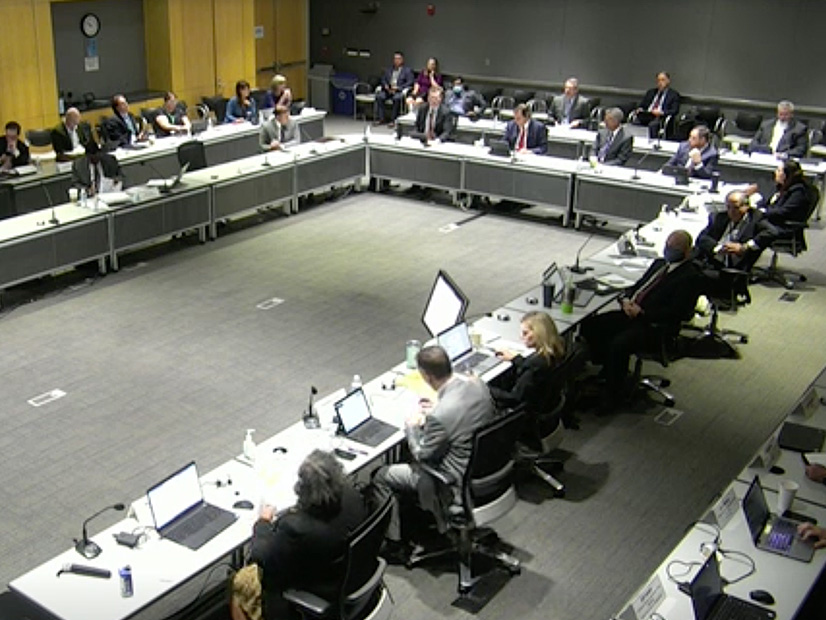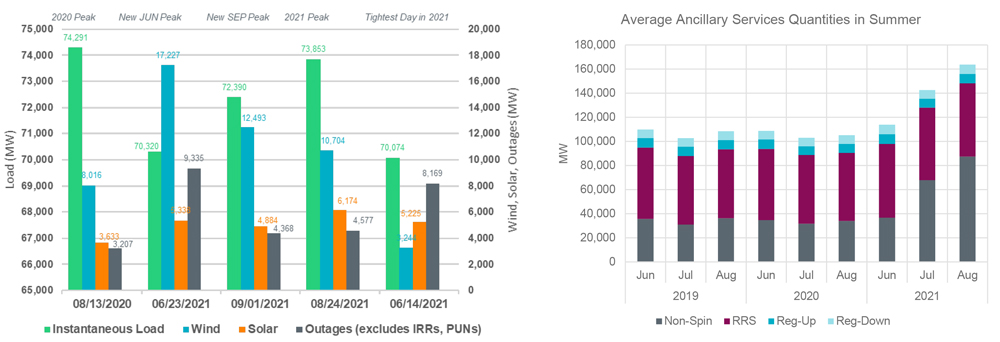
Grid Operator Expects Tight Conditions, Outages Remain High
Interim ERCOT CEO Brad Jones told his Board of Directors on Friday that tight operating conditions Monday may necessitate a conservation call, setting off a flurry of comments from the regulators present that the call is just one “tool in the toolbox” for maintaining reliability.
A similar conservation call in April spooked legislators and customers when conditions approached the criteria for a first-level energy emergency alert. (See ERCOT Faces Tight Conditions — Again.)
Unusually high demand and above-normal seasonal generation outages were to blame for the near-emergency. ERCOT anticipates similar conditions Monday, when temperatures are projected to creep into the low 90s, while wind production is expected to be low and thermal outages remain above normal. The grid operator expects about 63 GW of demand, 8 GW or so up from last week.
Jones stressed that ERCOT was not calling for conservation, but only monitoring the conditions.
“If we need to call for conservation, we will do that before the event and we will make sure that all Texans are aware of the condition,” Jones told the board. “If we need conservation, that is to ensure the grid remains reliable. We won’t be drawing ourselves out of an unreliable condition, we will be preparing and communicating to customers in advance if we need to do so.”
Public Utility Commission Chair Peter Lake interrupted Jones’ CEO report to remind those Texans who might be watching the meeting’s video stream that “conservation is another tool in the toolbox … used in grid operations around the world.”
“The PUC’s expectations and encouragement is that the EROCT operations team will take all measure necessary to prevent us from getting into an emergency,” he said.
Commissioners Will McAdams and Lori Cobos echoed Lake’s comments. Jimmy Glotfelty was available by phone but did not offer a comment.
Board Chair Paul Foster said he agreed with the commissioners and added that he expected ERCOT “to take any action necessary under its broad reliability authority to avoid an EEA condition” and to ensure grid reliability.
“Texas expects nothing less than for the grid operator to use all available tools at its disposal, and distribution-voltage reduction is one of those important reliability tools,” Foster said, reading from a document in front of him.
He then instructed ERCOT staff to file an urgent revision request giving the grid operator “ultimate flexibility” to use voltage-reduction measures before declaring an EEA. Foster asked that the Technical Advisory Committee bring the measure to the board for its consideration in November.
The TAC last week canceled this Wednesday’s meeting because of a lack of time-sensitive items to consider. It is next scheduled to meet next on Nov. 17.

ERCOT has maintained conservative operations since the April event and another in June, when wind generation failed to show up. The grid operator has increased the operating reserves and reliability unit commitments it deploys and has been doing so sooner. It is expecting about 17 GW of thermal outages, which is down from a high of 24 GW last week.
Lake: No-go for TAC’s Status Quo
As TAC Chair Clif Lange, with South Texas Electric Cooperative (STEC), wrapped up his update to the board, he was reminded of the political realities overhanging the market participant-driven committee.
ERCOT has rolled out a 60-point roadmap to grid reliability that includes an item ensuring the TAC is composed of “senior-level members from each member organization.” The committee, currently comprising 30 members representing seven market segments, engaged in a sometimes testy exchange with Jones during its July meeting over the level of stakeholder involvement. (See ERCOT Technical Advisory Committee Briefs: July 28, 2021.)
Lake complimented the committee on its work before segueing into concerns that market participants wield too much influence in ERCOT.
“We do know that after [legislation passed this year], that status quo is not what the path forward needs to look like. I don’t know what the path forward will be with our new board members … but I’m confident they will be evaluating the stakeholder process to ensure that we make improvements where we need to make them, while also retaining the valuable elements of what TAC has done to date,” he said, nodding to the three voting members currently on the board.
“Stakeholder input is critical to making this market work well, but I also know we can’t continue with business as usual,” Lake said. “I have full faith in these gentlemen to make improvements that we at the commission expect and that the legislature and the governor expect.”
Foster said he agreed with Lake and that he expected the board will “propose a number of changes while we continue to work with TAC and the whole team.”
The board still has room for six new directors following legislation this year that revamped its makeup. The PUC chair and ERCOT’s CEO will sit on the board as non-voting members. (See New ERCOT Board Approves Governance Changes.)
Jones to Launch Listening Tour
ERCOT has launched a statewide listening tour, with stops in locations like Odessa in West Texas and Brownsville in the Rio Grande Valley. Jones, who is to meet with business and community leaders in dozens of communities across states, said one of the scheduled stops includes a town hall in Carrollton, a northern suburb of Dallas.
“I know what the conditions were [during the February winter storm]. I know how difficult it was for consumers,” he said. “I want them to have the opportunity to tell me directly and hear them out. I want to make sure the people know what we are trying to achieve.”
Jones said ERCOT and the rest of the state is well ahead of the recommendations included in FERC and NERC’s recent preliminary report on the winter storm.
“We have already been addressing every one of those items,” he said.
ERCOT is facing a $35.2 million negative variance in its 2021 budget, driven by higher legal costs and a $26.4 million shortfall in revenue. System administration fees are off $9.2 million, but the grid operator’s interest income is down $19.8 million.
“It’s basically gone away,” Jones said. He noted staff had expected a 2.5% interest rate, but that is now a “very small fraction” of 1%.
The negative variance is essentially the same as it was in August, when it stood at $35.6 million.
Non-controllable Load Participation
The board approved 12 revision requests dating back to August, including an other binding document change (OBDRR032) that aligns non-spinning reserve deployment and recall procedures with revisions from a nodal protocol change (NPRR1093). The latter measure allows ERCOT to explore temporary workarounds for non-controllable load resources to participate in non-spinning reserves and provide additional capacity for the grid operator in the coming winter and summer seasons. The non-controllable resources will be deployed after offline units participating in non-spin. (See ERCOT Technical Advisory Committee Briefs: Sept. 29, 2021.)
STEC and Lower Colorado River Authority had both opposed the OBDRR over concerns that it presented a “discriminatory ‘last in, first out’ preference” for non-controllable resources, reducing the likelihood that they would “actually be called upon” over generation resources providing the same service and being compensated the same amount.
The utilities removed their objection following a recent non-spinning reserve service workshop and discussions with PUC and ERCOT staff that led to NPRR1011 being filed. The proposed measure provides a resource-neutral, deployment-grouping requirements by including generation providing offline non spin with non-controllable load resources proving non-spin reserve.
“The bottom line is this effort brings more resources to bear and increases the margin of safety for the ERCOT grid next summer,” Lake said.
Other approved changes included three additional NPRRs, another OBDRR, two changes to the planning guide (PGRRs), two system change requests (SCRs), and single revisions to the nodal operating guide (NOGRR) and the resource registration glossary (RRGRR):
-
-
- NPRR1082: changes the testing criteria for emergency response service (ERS) load with obligations less than 100 kW co-located with an ERCOT generator.
- NPRR1087: ensure any critical load in ERS programs can continue to support critical operations if they are deployed by requiring an attestation that the resource is not located behind an electric service identifier (ESI ID) for a critical load. The NPRR also requires a qualified scheduling entity representing an ERS resource to ensure and attest that it is not located behind an ESI ID for a critical load or itself is not the critical load.
- NPRR1090: clarifies that ERCOT has the flexibility to declare when exhausted ERS service types will be renewed for some or all of the ERS time periods and extends the deployment limit of weather-sensitive resources.
- NOGRR232: squares the guide with NPRR1093’s revisions.
- OBDRR033: matches the methodology for using the operating reserve demand curve to calculate the real-time deployment price adder with NPRR1093’s revisions.
- PGRR093: reinserts three requirements into the board-approved graybox language for PGRR082 that were inadvertently removed in its revisions.
- PGRR094: aligns the guide with current practices by grayboxing language requiring project construction start and completion date submittals until system implementation in the resource integration and ongoing operations-integration services system.
- RRGRR031: amends the glossary to accommodate registration of settlement-only energy storage systems to require the same level of registration detail required for energy storage resources under RRGRR023.
- SCR813: modifies the network model management system to highlight change submissions related to jointly rated equipment, listing other entities that have also provided ratings. The submitter will be asked to confirm that the requested changes have been coordinated with the associated companies.
- SCR814: introduces a limit on the total number of point-to-point obligation bid intervals that can be submitted into the day-ahead market per counterparty.
-
The directors also signed off on staff’s recommendation for a $101.5 million transmission project that addresses reliability and aging infrastructure needs in the Port Lavaca area on the Gulf Coast. Staff said they recommended a more expensive project to meet resiliency criteria along the coast. (See “Members Endorse $101M Tx Project,” ERCOT Technical Advisory Committee Briefs: Sept. 29, 2021.)



